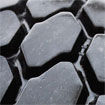
Tires: Definitions
This glossary includes key terms from the Guide and may be used as a companion to the text.
| Alignment | adjusting the angle of a vehicle's tires so that they are perpendicular to the road and parallel to each other. |
| All-season tires | tires designed for use across a range of weather conditions rather than for a particular type of weather (e.g., winter tires). |
| Balancing | adding of wheel weights to tires to compensate for imperfections resulting from the manufacturing process. |
| Dioxins | chemical compounds classified as persistent, bioaccumulative, and toxic (PBTs) by the EPA. |
| End-of-life management | process by which products are disposed of after their term of useful service expires. |
| Energy efficient | product that performs more work per unit of energy as compared to all similar products. |
| Hazardous substance | 1. material posing a threat to human health and/or the environment, that can be toxic, corrosive, ignitable, explosive, or chemically reactive, 2. substance that must be reported to the EPA if released into the environment. |
| High-performance tires | tires designed for higher speeds and greater traction. Typcially have higher rolling resistance than other types of tires. |
| Lead | soft, heavy metal used in tire wheel weights that can cause brain and kidney damage when ingested. |
| Lead-free wheel weights | wheel weights made of materials other than lead, such as steel, zinc, and plastic. |
| Low rolling resistance (LRR) tires | tires that improve vehicle fuel efficiency by reducing rolling resistance. LRR tires come standard on most new vehicles but are not not widely marketed as replacement tires. |
| LRR tires | see "Low rolling reistance (LRR) tires" |
| OEM tires | tires sold as original equipment on new vehicles. Often OEM tires are LRR tires. |
| Recapped tires | see "Retread tires" |
| Replacement tires | tires purchased to replace OEM tires. |
| Retread tires | used tires with core structure still intact and a new layer of rubber tread applied using similar techniques to OEM tire manufacture. Light-duty retread tires require 2 to 3 gallons of oil to produce whereas new light-duty tires require 7 to 8 gallons. |
| Rolling resistance | the amount of contact between tires and the road surface. Rolling resistance is influenced by tire inflation and design, vehicle load and speed, and road surface. Each 10% reduction in rolling resistance improves vehicle fuel economy by 1-2%. |
| Rolling resistance co-efficient (RRC) | quantitative measure of a tire's rolling resistance. RRCs for new tires are typically between 0.007 and 0.014 (NAS, 2006), with a lower number representing a lower rolling resistance. An LRR less than 0.0105 can be considered "low" rolling resistance (Green Seal, 2003). |
| Rotation | periodic movement of tires to new wheel positions to promote even wear. |
| Run-flat tires | tires with reinforced sidewalls that allow the vehicle to continue traveling at speeds upwards of 40 mph for a limited distance even with no inflation. |
| SAE 1269 | widely accepted rolling resistance testing procedure designed by the Society of Automotive Engineers. |
| Speed rating | speed at which a tire can safely operate. |
| Steel | hard, strong allow of iron and carbon that can be used as a substitute for lead wheel weights. Steel can corrode when exposed to water and air, thus steel wheel weights typically require a thin coating of zinc or plastic. |
| Tread | grooved surface of a tire that can vary in depth and pattern based on tire design. |
| VOC | see "volatile organic compounds" |
| Volatile organic compound (VOC) | organic compound that typically vaporizes at room temperature and participates in atmospheric photochemical reactions. |
| Wheel weight | blocks of heavy material, typically lead, affixed to tires for balancing. Each light-duty tire typically has 4.5 ounces of lead clipped to it. Around 2,000 tons of lead wheel weights fall off of vehiles each year in the United States. |
 |
This work by the Responsible Purchasing Network is licensed under a Creative Commons Attribution-Noncommercial-No Derivative Works 3.0 United States License. |
Feedback on this Guide
Please contact us with corrections, additions, policies, or questions.
![]() Submit Feedback
Submit Feedback


